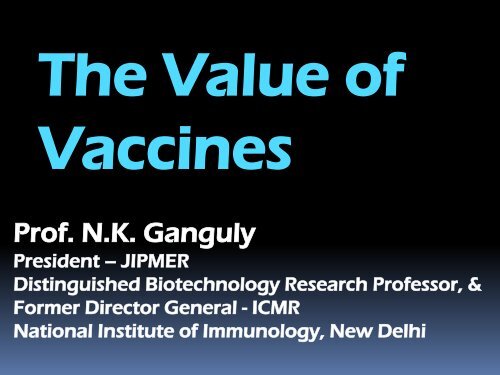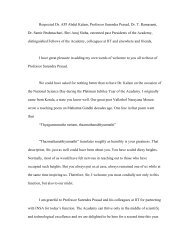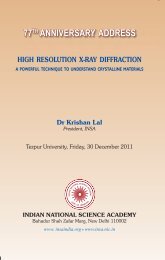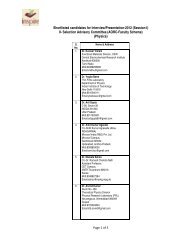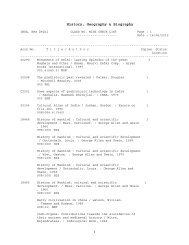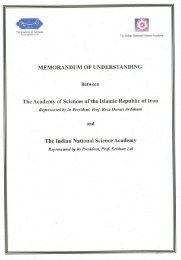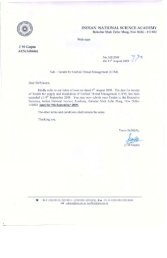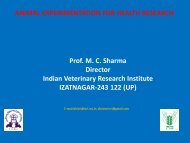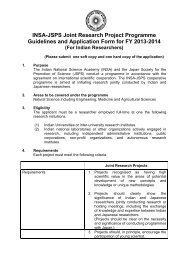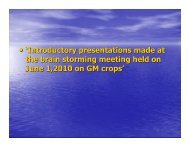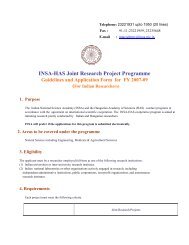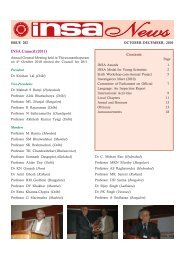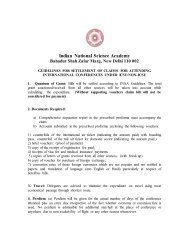Prof. N.K. Ganguly - Indian National Science Academy
Prof. N.K. Ganguly - Indian National Science Academy
Prof. N.K. Ganguly - Indian National Science Academy
You also want an ePaper? Increase the reach of your titles
YUMPU automatically turns print PDFs into web optimized ePapers that Google loves.
The Value of<br />
Vaccines<br />
<strong>Prof</strong>. N.K. <strong>Ganguly</strong><br />
President – JIPMER<br />
Distinguished Biotechnology Research <strong>Prof</strong>essor, &<br />
Former Director General - ICMR<br />
<strong>National</strong> Institute of Immunology, New Delhi
Variolation Pre-dates Vaccination<br />
� History of “Vaccination” begins with<br />
“Variolation” i.e. the intentional inoculation with<br />
“Smallpox” or “Variola” to prevent the disease.<br />
� Some scholars say that “Variolation” might have<br />
originated in India and attributed to Dhanvantari,<br />
founder of the Vedic Tradition in ~ 1500 BC.<br />
� Others say it was first used in Chinese Medicine<br />
during the 10 th Century AD.
Introduction of Variolation to the West<br />
• The practice was introduced to the west<br />
by Lady Mary Wortley Montagu (1689 – 1762).<br />
• Lady Montagu's husband, Edward Wortley<br />
Montagu, served as the British ambassador to<br />
the Ottoman Empire from 1716 to 1717.<br />
• She witnessed inoculation being practiced by<br />
physicians in Istanbul, and was greatly<br />
impressed.<br />
• She had her children inoculated by variolation.<br />
• The practice slowly gained popularity in the<br />
West.<br />
Lady Mary<br />
Wortley Montagu<br />
(~ 1716)
1749 - 1823<br />
Edward Jenner –<br />
Dawn of the Vaccine Era
Jenner’s House –<br />
Birthplace of “Vaccination”
Jenner’s “Temple of Vaccinia”<br />
An 18th century small building of stone under a thatched roof. It is decorated<br />
around its doorway and inside with large sections of bark from forest trees. It<br />
contains a small fireplace. In this building Edward Jenner vaccinated the poor<br />
people of the district, without charging any fees.
Sarah Nelmes – The Milkmaid<br />
who Helped to give Birth to<br />
“Vaccination”<br />
The hand and upper arm of Sarah Nelmes (1798). Photo<br />
courtesy of the <strong>National</strong> Library of Medicine
Edward Jenner Vaccinating<br />
James Phipps<br />
1796
Jenner and his Cowpox Vaccine<br />
1802 caricature of Jenner vaccinating patients who feared<br />
it would make them sprout cow-like appendages.
Jenner’s Original Manuscript –<br />
Royal College of Surgeons, London<br />
The medical establishment, as<br />
cautious then as now,<br />
considered his findings for<br />
some time before accepting<br />
them. Eventually vaccination<br />
was accepted, and in 1840 the<br />
British government banned<br />
variolation – the use of<br />
smallpox itself – and provided<br />
vaccination – using cowpox –<br />
free of charge.
Origin of the Term “Vaccination”<br />
� The word “vaccination” was first used by<br />
Edward Jenner in 1796.<br />
� Vaccination (Latin: vacca - cow) is so named<br />
because the first vaccine was derived from the<br />
relatively benign cowpox virus, which provides<br />
a degree of immunity to smallpox, a contagious<br />
and deadly disease.<br />
� In common speech, “vaccination” and<br />
“immunization” in general have the same<br />
colloquial meaning.
Louis Pasteur and the<br />
World’s First Rabies Vaccine<br />
1822 – 1895<br />
He developed his rabies vaccine by<br />
growing the virus in rabbits, then<br />
drying the affected nerve tissue to<br />
weaken the virus. On July, 1885, the<br />
vaccine was administered to Joseph<br />
Meister, a 9-year-old boy who had<br />
been attacked by a rabid dog. The<br />
boy survived and avoided<br />
contracting rabies, which would<br />
have almost certainly proved fatal.
Joseph Meister and Pasteur’s<br />
Rabies Vaccine<br />
1876 - 1940<br />
1885
Vaccination Strategies<br />
Prophylactic Vaccine: Administered before<br />
exposure to an infectious agent (or soon after<br />
exposure in certain cases).<br />
� Prevention<br />
Therapeutic Vaccine: Administered during an active<br />
infection.<br />
� Treatment
Traditional Vaccines<br />
• Types:<br />
� Inactivated (Killed): DPT<br />
� Live-attenuated: MMR, BCG<br />
• Using whole Microbes:<br />
� Virus<br />
� Bacteria<br />
� Parasites<br />
Virus
Major Vaccine Types<br />
Protein Subunit Vaccines:<br />
• Hepatitis B Vaccine (HBsAg)<br />
• Human Papillomavirus (HPV) Vaccine (L1)<br />
• Influenza Vaccine (H and N)<br />
Conjugate Vaccines:<br />
• Haemophilus influenzae type B Vaccine.<br />
• Pneumococcal Conjugate Vaccine.<br />
Combination Vaccines:<br />
• Bivalent: OPV (Type 1 + Type 3)<br />
• Trivalent: DPT, MMR<br />
• Tetravalent: DPT + IPV<br />
• Pentavalent: DPT + HepB + Hib<br />
• Hexavalent: DPT + HepB + Hib + IPV
Adjuvants<br />
� Enhance immunogenicity.<br />
� Reduce amount of antigen.<br />
� Reduce number of immunizations.<br />
Human Use<br />
Aluminium Salts<br />
� Aluminium phosphate sulphate or Alum<br />
� Aluminium hydroxide<br />
� Aluminium phosphate<br />
Oil Emulsions<br />
� MF59 - Uses Squalene (Chiron, now Novartis).<br />
� QS-21 – Purified saponin from the bark of Quillaja saponaria.<br />
� MPL - Monophosphoryl Lipid A from Salmonella minnesota (Corixa).<br />
� ASO4 – Aluminium salt + MPL (GSK).<br />
Animal Use<br />
� Complete Freund’s Adjuvant (CFA)<br />
� Incomplete Freund’s Adjuvant (IFA)
Vaccination as a Disease<br />
Prevention Tool
Vaccination for Preventing<br />
Diseases<br />
� Vaccination, as a preventive strategy, is considered to be<br />
the most cost-effective medical intervention in the fight<br />
against infectious diseases.<br />
� Vaccination Success Story: Diseases that are under<br />
control / nearly eliminated in developed countries –<br />
MMR, Hepatitis B, Hib and DPT. Polio nearly eradicated.<br />
� With the exception of clean, safe drinking water, proper<br />
sanitation, and housing, no other medical intervention<br />
rivals vaccination in tackling infectious diseases and<br />
reducing mortality rates.
Vaccines: Facts and Figures<br />
� Currently, vaccines are available against 26<br />
infectious diseases – many more in the pipeline.<br />
� Before smallpox eradication in 1977, the disease<br />
threatened 60% of the world’s population.<br />
� Between 1999 and 2003, measles deaths<br />
decreased worldwide by almost 40%.<br />
� Vaccines save over 2 million children every year.
Vaccination can<br />
Prevent Major<br />
Childhood Diseases
Child Mortality in India<br />
Congenital<br />
abnormalities<br />
3%<br />
Neonatal<br />
sepsis<br />
7%<br />
Other<br />
22%<br />
Birth<br />
asphyxia<br />
10%<br />
Preterm birth<br />
complications<br />
14%<br />
Pneumonia<br />
20%<br />
Diarrhea<br />
13%<br />
Measles<br />
4%<br />
Meningitis<br />
2%<br />
Pertussis<br />
5%<br />
Black et al. Lancet 2010; 375 (9730):1969-87 Year of estimate :2008
Causes of Death<br />
for 2 Million<br />
Children Under<br />
Age 5, by State<br />
Group, 2004<br />
EAGA: Empowered Action Group<br />
states plus Assam<br />
SOURCE: Jha and Laxminarayan (2009) Choosing Health - An Entitlement for all <strong>Indian</strong>s, CGHR
Pneumonia –<br />
Major Etiologic Agents<br />
Streptococcus pneumoniae Haemophilus influenzae Type B<br />
Gram Positive<br />
Bacterium<br />
Gram Negative<br />
Bacterium
Major Symptoms of Pneumococcal<br />
and Hib Infections
Prevnar<br />
Pneumococcal Vaccines<br />
� 7-valent vaccine, manufactured by Wyeth. In the USA,<br />
vaccination with Prevnar is recommended for all children
Hib Vaccines<br />
� First Hib vaccine licensed was a pure polysaccharide vaccine, first<br />
marketed in the US in 1985.<br />
� Conjugate Vaccine: The shortcomings of the polysaccharide<br />
vaccine led to the production of the Hib polysaccharide-protein<br />
conjugate vaccine. Attaching Hib polysaccharide to a protein<br />
carrier greatly increased the ability of the immune system of<br />
young children to recognize the polysaccharide and develop<br />
immunity.<br />
� Hib conjugate vaccines have been effective against all<br />
manifestations of Hib disease, with a clinical efficacy between<br />
95-100%.
<strong>Indian</strong> Hib Combo Vaccines<br />
Company Type of Vaccine Date of WHO<br />
Pre-qualification<br />
Serum Institute<br />
of India Ltd.<br />
Serum Institute<br />
of India Ltd.<br />
Biological E<br />
Ltd.<br />
Quadrivalent: DPT<br />
(whole cell) + Hib<br />
Pentavalent: DPT<br />
(whole cell) + HepB +<br />
Hib<br />
Pentavalent: DPT<br />
(whole cell) + Hep B +<br />
Hib<br />
June 23, 2010<br />
May 26, 2010<br />
August 31, 2011
Diarrhoeal Disease<br />
in Children
� 4.6 million children below 5 years of age die of<br />
diarrhoeal diseases ⇒ This constitutes 19% all<br />
childhood deaths.<br />
� 85% of diarrhoeal deaths occur in the first year of<br />
life.<br />
Diarrhoea –<br />
A Major Killer of Children !<br />
� In India, 0.3 million deaths occur annually in<br />
children below 5 years of age*<br />
Source: WHO 1997. WHO Fact Sheet: Reducing Mortality from Major Childhood Killer<br />
Diseases. Fact Sheet Number 180. http://www.who.int/chd/pub/imci/fs_180.html<br />
* Million Death Study Lancet. 2010; 376 (9755): 1853-1860.
� Virus<br />
� Rotavirus*<br />
� Norovirus*<br />
� Bacteria<br />
Aetiological Agents<br />
� Enterotoxigenic E. coli<br />
� Shigella*<br />
� Salmonella<br />
� Vibrio Cholerae*<br />
� Campylobacter jejuni<br />
� Yersinia pestis<br />
Rotavirus<br />
* Common Causes of epidemic diarrhoea<br />
� Protozoan Parasites<br />
E. coli<br />
� Giardia<br />
� Entamoeba histolytica<br />
� Cryptosporidium<br />
Giardia<br />
Source: WHO 1997: http://www.who.int/chd/pub/imci/fs_180.html
Rotavirus Diarrhoea
Rotavirus<br />
� Leading cause of<br />
diarrhoea in infants and<br />
young children<br />
worldwide.<br />
� Causes >0.5 million<br />
deaths in children
Rotavirus (RV) Type A: The Most Common Cause<br />
of Infections in Humans<br />
Globally: Rotavirus causes 40% of all diarrhoea<br />
and 527,000 deaths annually in infants.<br />
20-30% of hospitalized patients<br />
with diarrhoea +ive for rotavirus.<br />
Source: WHO
Rotavirus Vaccines
Licensed Oral Rotavirus<br />
Vaccines (ORV)<br />
• Rotarix (GSK, Belgium) – Human monovalent<br />
live attenuated RV strain (RV1). Intl. License.<br />
Price: 5,255 INR<br />
• RotaTeq (Merck, USA) – Pentavalent live<br />
bovine-human reassortant RV strain (RV5). Intl.<br />
License. Price: 3,536 INR
Rotavirus Vaccines: The Problem of Low<br />
Vaccine Efficacy in Developing Countries<br />
Rotarix Trials in South<br />
Africa and Malawi<br />
Randomized, Placebocontrolled,<br />
Multicenter Trial<br />
Vaccine Efficacy<br />
Malawi<br />
South<br />
Africa<br />
South Africa: 76.9% Malawi: 49.4% Efficacy far lower<br />
in Malawi !<br />
NEJM 2010; 362: 289-98.
The <strong>Indian</strong> ORV 116E Holds<br />
Promise for Developing<br />
Countries<br />
� Strain 116E human rotavirus Serotype<br />
G9, P with single gene coding VP4.<br />
� 1×10 5 Focus forming unit found safe and<br />
immunogenic in clinical trials in USA and<br />
India. Robust immune response after 3<br />
administrations.<br />
� 4 fold increase rotavirus IgA titer in<br />
89.7% of infants recipient of ORV.<br />
� Technical Collaborators: DBT (India)<br />
CDC (USA), NIH (USA), Stanford<br />
University and PATH<br />
� Development by Bharat Biotech<br />
International Limited (Hyderabad, India)<br />
Neonatal strain 116E<br />
Isolated at AIIMS<br />
New Delhi<br />
Bhandari et al. J Infect Dis 2009; 200: 421-429
Other <strong>Indian</strong> Rotavirus Vaccines in<br />
the Pipeline<br />
� Bharat Biotech Limited: Has plans to develop a<br />
Rotavirus vaccine “Rotavac”, priced at only<br />
USD1 in collaboration with GAVI and DBT.<br />
� Sanofi Pasteur (Shantha Biotech): In<br />
collaboration with PATH, coming up with<br />
Rotavirus vaccines.
Tackling Childhood Diarrhoea –<br />
Direct:<br />
Other Strategies<br />
� Oral Rehydration Therapy.<br />
� Zinc Supplementation.<br />
Indirect:<br />
� Improvements in Hygiene and Sanitation.<br />
Source: http://www.who.int/immunization/topics/rotavirus/en/
Other Important<br />
Vaccine Trials for<br />
Enteric Diseases
Cholera Vaccine Trials, Kolkata<br />
NICED – IVI / DOMI Collaborative Projects<br />
Safety and immunogenicity (Phase-II) and RCT (Phase-III) trials of bivalent (01<br />
and 0139) killed, whole cell oral cholera vaccine in <strong>Indian</strong> subjects in Kolkata,<br />
West Bengal<br />
Developed by IVI and ICMR with funding from BMG Foundation. Technology<br />
transferred to Shantha Biotech for commercial development. Now marketed<br />
as Shanchol <br />
In April 2009 policymakers in India<br />
decided in a meeting (pictured) organized<br />
by the IVI and India's <strong>National</strong> Institute of<br />
Cholera and Enteric Diseases (NICED) to<br />
conduct a pilot cholera vaccination<br />
program in a highly cholera-endemic rural<br />
area of Orissa, using the Shanchol<br />
vaccine.
Typhoid Vaccine Trials, Kolkata<br />
NICED – IVI / DOMI Collaborative Projects<br />
• Randomized controlled evaluation of protection by the Vi<br />
polysaccharide vaccine against typhoid fever in Kolkata, West Bengal<br />
− To determine the protective effectiveness of the Vi polysaccharide vaccine<br />
− To monitor the safety and immunogenicity of the Vi polysaccharide vaccine<br />
Typherix ® (Trial Vaccine)<br />
25 ug Vi polysaccharide of S. typhi<br />
(adults and children)<br />
Licensed in India<br />
Havrix ® (Placebo)<br />
1440 EL.U. of viral antigen – Adults<br />
720 EL.U. of viral antigen –<br />
Pediatrics Licensed in India<br />
Major Findings<br />
• Vi vaccine conferred 61% protection<br />
• Highly protective in young children<br />
(80%)<br />
• Showed indirect protection (44%) in<br />
non-vaccinated neighbors of Vivaccinees<br />
• Overall protection - 57%<br />
• Evidence shows that this vaccine may<br />
be introduced in typhoid endemic zone
Other Major Vaccine<br />
Trials in India
HIV / AIDS Vaccine Candidates:<br />
Phase - I Clinical Trials<br />
tg AACO9 HIV-1 Vaccine Phase<br />
1 Trial, NARI, Pune:<br />
� Vaccine well tolerated at 3 doses<br />
used.<br />
� Weakly immunogenic.<br />
� Evidence of high baseline titer of<br />
AAV2 neutralizing antibody in<br />
<strong>Indian</strong> population as compared to<br />
European participants.<br />
tg AAC09 - Adeno-Associated Virus (AAV)<br />
based Vaccine<br />
MVA Vaccine Trial, TRC, Chennai:<br />
� Dose-dependant response seen.<br />
� TBC-M4 immmunogenic at both low and<br />
high dose with 75% and 100% of low and<br />
high dose vaccinees responding after 3<br />
injections.<br />
� Most responses were balanced, directed<br />
to both env and gag, then against pol, nef<br />
or tat-rev.<br />
� Lack of impact of previous smallpox<br />
vaccination on response rate.<br />
TBC-M4 (Modified Vaccinia Ankara (MVA)<br />
HIV-1 multigenic subtype C) Vaccine<br />
SspI (16042)<br />
EcoRV (15381)<br />
EcoRV (15233)<br />
EcoRV (15165)<br />
HindIII (15032)<br />
PstI (14937)<br />
SacI (14674)<br />
Kozak<br />
NcoI (14503)<br />
PstI<br />
NotI (8991)<br />
pT216 [8979-17938]<br />
(8960 bp)<br />
HindIII (14170)<br />
SspI (13539)<br />
sE/L<br />
SacI (9539)<br />
EcoRV (9396)<br />
NcoI (9629)<br />
nef<br />
AAAAA<br />
EcoRV (12827)<br />
EcoRV (13058)<br />
P 73 RT<br />
ScaI (10459)<br />
ScaI (10578)<br />
NN<br />
NcoI<br />
KpnI<br />
Pv uII<br />
KpnI<br />
ICMR
Measles Aerosol Vaccine Trial<br />
� <strong>National</strong> Institute of Virology -<br />
KEM, Pune<br />
� NICED - BC Roy Children<br />
Hospital, Kolkata<br />
� <strong>National</strong> Institute of<br />
Epidemiology - King Institute -<br />
Institute of Child Health,<br />
Chennai<br />
� Study funded by WHO<br />
Phase-I Trial Sites
India is a Supplier of<br />
World-Class Vaccines
India has a Strong Presence in the<br />
Global Vaccine Scenario<br />
� Majority of <strong>Indian</strong> Vaccine Suppliers are WHO<br />
Prequalified.<br />
� Developing Country Vaccine Manufacturers Network<br />
(DCVMN) – <strong>Indian</strong> Members:<br />
� Bharat Immunologicals & Biologicals Corp.<br />
� <strong>Indian</strong> Immunologicals Ltd.<br />
� Bharat Biotech Intl. Ltd.<br />
� Haffkine Bio-Pharmaceutical Corp. Ltd.<br />
� Panacea Biotec<br />
� Biological E<br />
� Serum Institute of India<br />
� Zydus Cadila<br />
� Chiron Behring Vaccines Pvt. Ltd.<br />
Pink: WHO<br />
prequalified<br />
vaccine<br />
manufacturers
Major Players in the <strong>Indian</strong> Vaccine<br />
Shantha Biotech,<br />
Hyderabad<br />
Panacea Biotec,<br />
New Delhi<br />
Zydus Cadila,<br />
Ahmedabad<br />
Serum Institute of<br />
India, Pune<br />
Industry<br />
Hepatitis B (recombinant),<br />
DTwP-Hep B (Shantetra),<br />
TT (Shan TT), DTwP-Hepatitis B-Hib (Shan5)<br />
(1 dose and 10 doses)<br />
DTwP Biofarma - Hib Novartis (EASYFOUR)<br />
DTwP Biofarma - Hepatitis B PHB (ECOVAC)<br />
DTwP Biofarma - Hep B PHB- Hib PHB (EASYFIVE)<br />
Hepatitis B (Enivac B)<br />
OPV (from bulk supplied by Biofarma, Indonesia)<br />
OPV (from bulk supplied from Chiron, Italy)<br />
Rabies, Influenza<br />
BCG, DT, dT, DTwP, DTwP-Hep B, Hep<br />
B (recombinant), TT, MR, MMR, measles, rubella<br />
Haffkine, Mumbai OPV (from bulk supplied by Biofarma, Indonesia)
Vaccines:<br />
Major Contributions by<br />
<strong>Indian</strong> Companies
Shantha’s Contributions: Recombinant<br />
Hepatitis B and Cholera Vaccines<br />
Shanchol: Developed by IVI and ICMR<br />
with funding from BMG Foundation.<br />
Technology transferred to Shantha<br />
Biotech for commercial development.<br />
A Pioneer in<br />
Manufacturing<br />
Low-cost<br />
Recombinant<br />
Hepatitis B<br />
Vaccine
Serum Institute of India’s Meningococcal A<br />
Conjugate Vaccine – A Boon for Africa<br />
MenAfriVac <br />
MenAfriVac (Meningococcal A Conjugate vaccine) is a<br />
lyophilized vaccine of purified meningococcal A<br />
polysaccharide covalently bound to tetanus toxoid<br />
(TT), which acts as a carrier protein. The vaccine<br />
consists of purified group-specific bacterial<br />
polysaccharide from Neisseria meningitidis group A.<br />
Meningitis Vaccine Project<br />
• 2010-2012: 55 million people<br />
vaccinated, aged 1-29 years.<br />
• 2011: 21 million people<br />
vaccinated in Cameroon, Chad<br />
and Nigeria.
Vaccine Clinical Trial Facilities<br />
� <strong>National</strong> Institute of Cholera and Enteric Diseases (NICED), Kolkata<br />
� <strong>National</strong> Institute for Research in Tuberculosis (NIRT)*, Chennai<br />
� Vadu Rural Health Program, King Edward Medical (KEM) College and Hospital,<br />
Mumbai<br />
� Postgraduate Institute of Medical Education and Research (PGI), Chandigarh<br />
� Christian Medical College (CMC), Vellore<br />
� <strong>National</strong> AIDS Research Institute (NARI), Pune<br />
� Society for Applied Studies (SAS), Kolkata and New Delhi<br />
� Medanta Duke Research Institute (MDRI) – A Joint venture partnership between Duke<br />
Medicine and Medanta Medicity in New Delhi – Early phase clinical site (up-coming)<br />
� Quintiles & Apollo – Clinical Trials Unit at Hyderabad (up-coming)<br />
* Formerly Tuberculosis Research Centre (TRC)
State-of-the-Art Vaccine Trial<br />
Information / Education Room<br />
Facilities, NARI<br />
Immunology Lab<br />
Clinical Room
State-of-the-Art Vaccine Trial<br />
Facilities, NIRT *<br />
* Formerly Tuberculosis Research Centre (TRC)
New Vaccine<br />
Technologies
DNA Vaccines
DNA Vaccine Construct<br />
� Multiple Cloning Site –<br />
For inserting the gene<br />
of interest.
How do DNA<br />
vaccines work ?
DNA Vaccine: Delivery
The Helios ® Gene Gun
Gene Gun: Principle of Operation<br />
Helium<br />
Gas<br />
Firing Pressure:<br />
Mice: 200 psi<br />
Monkey: 500 psi<br />
Gold Microparticles : 1 µm diameter
Advantages of DNA Vaccines<br />
� Safer to produce, since culture of dangerous<br />
infectious agents are not involved.<br />
� Since only DNA is used, there is no chance of<br />
virulence due to reversion.<br />
� Cheaper to produce, since protein expression<br />
and purification is not involved.<br />
� Logistically feasible, since cold-chain will not<br />
be required due to stability of DNA.<br />
� Economically feasible, since one plasmid can<br />
encode for more than one antigen.
Fears about DNA Vaccines<br />
� DNA integration.<br />
� Autoimmunity.<br />
� Immunologic tolerance.<br />
No supporting<br />
data so far…
Virus Like Particles –<br />
A Novel Vaccine<br />
Platform
Virus Like Particles<br />
� Virus-like particles (VLPs) resemble<br />
viruses, but are non-infectious because<br />
they do not contain any viral genetic<br />
material.<br />
� The expression of viral structural<br />
proteins, such as Envelope or Capsid,<br />
can result in the self-assembly of VLPs.<br />
� VLP Technology has been employed for<br />
vaccine development against a variety<br />
of viruses, including Influenza Virus<br />
and Human Papilloma Virus (HPV).<br />
EM of VLPs<br />
Atomic model of a VLP
Expression Systems<br />
Prokaryotic<br />
(Bacteria)<br />
Eukaryotic<br />
(Yeast)<br />
� E. coli � Saccharomyces cerevisiae<br />
� Pichia pastoris<br />
� Hansenula polymorpha
72 Pentamers (Capsomeres) of<br />
L1 Comprise the Viral Capsid
Atomic Structure of HPV16<br />
L1 Pentameric Capsomeres
VLPs Structurally Resemble<br />
the Viral Capsid
In vitro assembly may generate<br />
particles of different sizes<br />
T = Topology<br />
T = 7<br />
T = 3<br />
T = 1
Capsomeres Spontaneously<br />
Assemble in vitro<br />
TEM of VLPs
VLP based Vaccines being<br />
Developed in India<br />
DBT, Government of India<br />
� HPV Vaccine ⇒ R&D<br />
Cadila Biopharmaceuticals<br />
� Joint Venture between Cadila and Novavax (USA)<br />
⇒ H1N1 Vaccine (R&D and Scale-up)
Infectious Diseases for<br />
which Vaccines are<br />
Urgently Needed –<br />
The BIG THREE !
Tuberculosis<br />
� No vaccine except BCG.<br />
� AERAS Vaccine Candidates: MVA85A, AERAS-402,<br />
GSK M72, AREAS-422 (rBCG), SSI / SP H4-IC31<br />
Malaria<br />
� Recombinant fusion protein of P. falciparum CSF +<br />
HBsAg: Initial Phase III Trials completed. Final<br />
Phase III data will be available in 2014.<br />
� Other candidates, many years behind.<br />
HIV/AIDS<br />
� No vaccine successful yet.<br />
� RV144 Trial completed in Thailand.<br />
� Ongoing Trials: UKHVC, BMGF, CHAVI-ID
Elucidating the<br />
Value of Vaccines
Socio-Economic Value of<br />
Vaccination<br />
• An important tool for increasing attendance:<br />
• In schools and colleges.<br />
• In offices.<br />
• An important tool for poverty reduction:<br />
• Potential to reduce burden of major diseases of<br />
poverty, with availability of new vaccines e.g. TB,<br />
Rheumatic Fever / Rheumatic Heart Disease, etc.<br />
• Potential to reduce Neglected Tropical Diseases<br />
(NTDs) like Kala-azar, with availability of new vaccine<br />
e.g. LEISHDNAVAX.
Vaccination Efforts Need to be<br />
Sustained in Order to be Effective<br />
� Sustained vaccination efforts have eradicated<br />
smallpox and lowered the global incidence of polio<br />
by 99%.<br />
� Historical evidence indicates that decrease in<br />
vaccination efforts leads to reappearance of<br />
disease.<br />
� Vaccination has averted 7.5 million deaths from<br />
measles.
Vaccination – Problems Remain<br />
� In all, 3 million people die each year from vaccine<br />
preventable diseases – (Center for Global Development, 2005)<br />
� Declining funding for immunization has been<br />
mirrored in stagnating or falling coverage.<br />
� Global coverage of the DPT vaccine has been stalled<br />
at around 74% since 1990 – (GAVI, 2003)<br />
� 57 developing countries have yet to eliminate<br />
neonatal tetanus, and 200,000 babies died of the<br />
disease in 2000 – (WHO, 2002)
Loss in Momentum in Universal<br />
Vaccine Coverage – Why ?<br />
� Easiest-to-reach populations have already been<br />
vaccinated. Unvaccinated populations living in<br />
inaccessible areas.<br />
� Practical problems impeding vaccine delivery:<br />
� Lack of good roads and reliable transportation .<br />
� Lack of knowledge of the value of vaccines, hence reluctant<br />
to be vaccinated.<br />
� Lack of trained staff and accessories (sterile syringes).<br />
� Lack of constant power supply.<br />
� Political Reasons: Immunization campaigns cannot<br />
operate in isolation; they are dependent on the<br />
prevailing political and social environment.<br />
� Economic Reasons: Vaccines like PCV and HPV currently<br />
too expensive.
Disparities in Immunization Rates<br />
100<br />
90<br />
80<br />
70<br />
60<br />
50<br />
40<br />
30<br />
20<br />
10<br />
0<br />
DPT Measles<br />
Source: World Bank, Washington DC (2004). Data are for 2002<br />
Europe and Central<br />
Asia<br />
South Asia<br />
Sub-Saharan Africa
Vaccine Development –<br />
A Long and Arduous Process<br />
� The process of researching, testing, gaining regulatory<br />
approval and manufacturing vaccines is a costly, complex and<br />
lengthy process.<br />
� Developing a new vaccine takes on average 18.5 years and<br />
costs over USD 800 million.<br />
� Such sustainable investment requires long-term<br />
commitment, predictable future demand and government<br />
policies that recognize the value of vaccination.<br />
� Long-term partnership and collaboration between policy<br />
makers, public health authorities and industry is also crucial.
Vaccine Development: A Costly Affair !<br />
Laboratory<br />
Development<br />
USD 800 million!<br />
Production<br />
Phase III trial<br />
Technology<br />
Transfer<br />
Phase II trial<br />
No Go<br />
Phase I trial<br />
No Go<br />
GMP Grade<br />
Material<br />
Preclinical Toxicity<br />
No Go<br />
Post-marketing surveillance further adds to the cost !<br />
No Go
Vaccine Discovery and Development –<br />
Changing Scenario<br />
The technological revolutions of the last 25 years shortened the path of discovery of<br />
new vaccines. However, while the discovery phase of vaccines is much shorter, today<br />
the development path, which costs approximately 10-fold than discovery, is much<br />
longer than in the past. (a) Vaccine discovery and development path in 1980; (b)<br />
vaccine discovery and development path in 2000. Source: Vaccine 2003; 21: S2/110
Historical Attractiveness of Vaccine<br />
Investment<br />
Source: <strong>Science</strong> 2002; 297: 937
Social vs Economic Value of Vaccines<br />
Source: <strong>Science</strong> 2002; 297: 937
What’s the Value of a Vaccine if<br />
Examples:<br />
it’s Under-utilized ?<br />
� Hepatitis B Vaccine ⇒ Programmatic Issue.<br />
� HPV Vaccine ⇒ Too Expensive.<br />
� Cholera Vaccine (Shanchol) ⇒ Lack of political<br />
commitment.
Intangible Value of<br />
Vaccination<br />
Infectious Diseases can<br />
wipe-out entire cities …
… the story of Siena, Italy<br />
The original front of the Siena<br />
cathedral, as it is nowadays. The<br />
front wall of the cathedral of Siena,<br />
the construction of which was<br />
interrupted by the plague in 1348.<br />
The plague wiped out over 70% of<br />
the population. The wall, with its<br />
gaping, monumental, windows,<br />
stands 664 years after the plague<br />
as a reminder of how devastating<br />
infectious diseases can be and<br />
represents the largest “monument<br />
to infectious disease” ever built by<br />
mankind.


